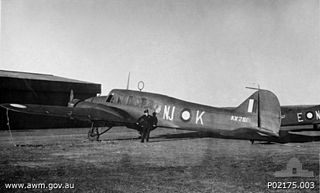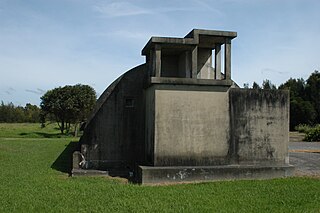
Tomaree is a national park located in New South Wales, Australia, 145–155 km (90–96 mi) northeast of Sydney in the Port Stephens local government area. It is located on the shores of the Tasman Sea, extending north from Fishermans Bay to Shoal Bay passing through Boat Harbour, One Mile, Nelson Bay and Fingal Bay.
Royal Air Force Station Foulsham, more commonly known as RAF Foulsham is a former Royal Air Force station, a military airfield, located 15 miles North-West of Norwich, in the English county of Norfolk, East Anglia, from 1942 to 1945.
Air traffic control in Australia is provided by two independent organisations, one civilian and one military. The civilian provider is Airservices Australia, which controls civilian airfields and airspace. The military provider is the Royal Australian Air Force (RAAF), which controls military airfields and adjoining airspace. This includes Australian Army and Royal Australian Navy aviation bases. Some airfields in Australia are categorised as Joint User airfields, where there are both civilian and military operations based at the airfield. Normally, Joint User airfields have air traffic control provided by the RAAF.

No. 452 Squadron is a Royal Australian Air Force (RAAF) air traffic control unit. It was established in 1941 as a fighter squadron, in accordance with Article XV of the Empire Air Training Scheme during World War II. The squadron flew Supermarine Spitfires for the entire war, initially over the United Kingdom and Nazi-occupied Europe. It was later based in Australia and the Netherlands East Indies, before being disbanded in 1945. It was re-raised in its current role in February 2011.
No. 44 Wing is a Royal Australian Air Force (RAAF) wing responsible for providing air traffic control services to the Australian Defence Force. It directly commands two squadrons, which in turn command eleven air traffic control flights located across the country at nine RAAF bases, HMAS Albatross and Oakey Army Aviation Centre. The wing was formed during World War II, in December 1942, and was disbanded in August 1944. It was re-established in its current form in November 2000.

No. 81 Wing is responsible for operating the McDonnell Douglas F/A-18 Hornet multi-role fighters of the Royal Australian Air Force (RAAF). Headquartered at RAAF Base Williamtown, New South Wales, the wing comprises three combat units, Nos. 3 and 77 Squadrons based at Williamtown and No. 75 Squadron at RAAF Base Tindal, Northern Territory, as well as an operational conversion unit at Williamtown. No. 81 Wing headquarters oversees squadron training in air-to-air and air-to-ground tactics, and support for the Australian Army and Royal Australian Navy. Tasked with offensive and defensive counter-air operations, the Hornets have been deployed to Diego Garcia in 2001–02, when they provided local air defence, to Iraq in 2003, when they saw action flying fighter escort and close air support missions in concert with Coalition forces, and to the Middle East in 2015–16, when they undertook strike operations during the military intervention against ISIL. They have also been employed to patrol high-profile events in Australia, including the Commonwealth Games and visits by foreign dignitaries.

No. 73 Squadron was a Royal Australian Air Force (RAAF) maritime patrol squadron of World War II. It was formed in July 1942 and conducted patrols off the east coast of Australia until July 1944. The squadron was disbanded in September 1944.

No. 5 Operational Training Unit was an operational training unit (OTU) of the Royal Australian Air Force. It was formed at Wagga Wagga, New South Wales, in October 1942 to train pilots and navigators for service in World War II. The unit was initially equipped with Bristol Beauforts and Beaufighters, and later received Douglas Bostons and de Havilland Mosquitos, among other types. No. 5 OTU was transferred to Tocumwal in October 1943, and then to Williamtown in mid-1944. It was reorganised as a fighter conversion unit flying P-51 Mustangs and CAC Wirraways in February 1946, and disbanded in July 1947.

No. 131 Radar Station RAAF is a heritage-listed former Royal Australian Air Force radar station at Kooragang, City of Newcastle, New South Wales, Australia. They are also known as the Radar Igloo and Radar Buildings. They now operate as the Estuarine Interpretive Centre.

No. 208 Radar Station RAAF is a heritage-listed former Royal Australian Air Force (RAAF) radar station at Mine Camp at Catherine Hill Bay and Pinny Beach, both in City of Lake Macquarie, New South Wales, Australia. It was established on 10 February 1943. The remains of the radar station were added to the New South Wales State Heritage Register on 22 July 2008.
No. 1 Fighter Sector (1FS) was a Royal Australian Air Force (RAAF) unit formed at Bankstown, New South Wales on 25 February 1942.

No. 4 Operational Training Unit was an operational conversion unit of the Royal Australian Air Force during World War II. It was formed at Williamtown, New South Wales, in October 1942 to train pilots and wireless air gunners to operate Vultee Vengeance dive bombers. The school was equipped with Vengeances and CAC Wirraway aircraft. Accidents were common in operational conversion units, and No. 4 OTU suffered several fatal crashes during its existence. It was disbanded in April 1944, handing Williamtown over to No. 5 Operational Training Unit.
No. 19 Radar Station RAAF was a Royal Australian Air Force radar station formed at Bombi near Bouddi, New South Wales, Australia on 15 April 1942.
No. 17 Radar Station RAAF was a Royal Australian Air Force radar station formed at Burrewarra Point, Guerilla Bay, New South Wales, Australia on 12 April 1943. The radar became operational on 29 April 1943 after initial training and setting up the radar equipment.
No. 18 Radar Station RAAF was a Royal Australian Air Force (RAAF) radar station formed at Richmond, New South Wales, Australia on 1 April 1942.
Broadmeadow Aerodrome was an aerodrome located at District Park, Broadmeadow, Newcastle, Australia, operating from 1929 to 1963.

The RAAF Base Williamtown Buildings are a heritage-listed group of Royal Australian Air Force (RAAF) buildings and other items at Medowie Road, RAAF Base Williamtown, New South Wales, Australia. It is also known as Williamtown RAAF Base Group. It was added to the Australian Commonwealth Heritage List on 22 June 2004.













